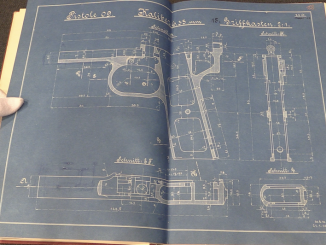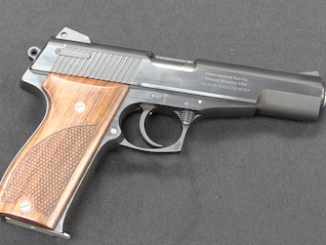Among the large family of roller-delayed rifles produced by Heckler & Koch, one of the rarest and least known is the HK32. This was the select-fire shoulder rifle chambered in 7.62x39mm. These rifles appeared in H&K sales literature for a time, but were only made in very small numbers for one or two poor documented contracts. What we have here today is a very early prototype rifle in 7.62x39mm using a regular NATO caliber receiver with a magazine well block to fit a proprietary H&K magazine. The rifle retains many CETME features, including the muzzle brake, metal forehand with integral bipod, carry handle, stock design, and a unique 2-position rear notch sight.
Many thanks to the Royal Armouries for allowing me to film and disassemble this very rare rifle! The NFC collection there – perhaps the best military small arms collection in Western Europe – is available by appointment to researchers. Anyone, however, can browse the various Armouries collections online here.




Considering that this is not likely to salvage magazines from existing stockpiles, there is very little wonder why developments were halted. Why not reverse-engineer a magazine already in production, namely that of the AK, just to cut down on logistical nightmares? I could have the wrong approach, but it could be worth a try…
when you look at the magazine well, it is the same shape as on a G3. They just put in that piece of steel with the magazine catch and flapper release. Changing the stampings to have a magazine well for AK pattern magazines would have been design work and higher cost to change the tooling for the origami like folding of the raw receiver stamping.
Alos back then, rarely it was thought of reusing the same magazine pattern in a different firearm. Every gun had its own special pattern.
addendum:
The rifle shown in this educational film is a prototype, so details were subject to change and delivered product might look differently. See for example the photos from Mexico linked in a comment further down.
“reverse-engineer a magazine already in production, namely that of the AK”
Well, while magazine is certainly simpler machine that weapon itself, it do not means reverse-engineering of it is easy task and copycat do not have to same reliability as original one. Also there is question about materials, could steel already used by HK feign that of AK, especially spring? If not you either need to add yet another steel type to production process or redesign (spring at least).
Finally, there is question: will it be of great importance of end user to justify additional effort?
If you export the weapon to a country that primarily uses the AK, the customer may not like the idea of having to buy “incompatible magazines.” For said end user, having two rifles firing the same cartridges from substantially different magazines might be a logistical headache. That’s what I was thinking, if we mention Iraqi use of the Czech VZ.58 alongside the AK. Iraqi soldiers could not interchange magazines if rifles were damaged and had to be replaced. I could be wrong…
Good you mention the incompatibility between magazines. This was probably most serious reason the vz.58 did not reach much international sales. The other is ammo itself in locations where it is not preferred. CZUB should have quickly after 1990 produce 5.56mm export version; the gun was mechanically sound.
“If you export the weapon to a country that primarily uses the AK, the customer may not like the idea of having to buy “incompatible magazines.” ”
Wait, I am confused now. So when exactly HK 32 was developed? It is Cold*War-era weapon xor modern era weapon?
* i.e. first prototype ready no later than July 1, 1991
Interestingly, there exist photo: https://www.thefirearmblog.com/blog/2009/04/15/mythical-hk32-seen-in-the-wild/ which supposedly shown HK32 in real world use.
A Colonel of the SEDENA in Mexico, when in 1998 I was a first class soldier, in a lunch he mentioned that indeed a contract was requested to the H & K company in 1986 for the first purchase of 600 rifles, unfortunately and bureaucratic issues, it was not achieved until May 1993, in which it was for first use in the military police and paratroop rifle brigades … later for a second purchase of 1000 rifles of which only 860 rifles were purchased, thanks again to the blessed bureaucracy; 10 rifles only for trials with designation hk232 as a light machine gun plus 4 hk32SG1 rifles but with another designation called hk32 / telescopico, unfortunately the rifles for light machine gun, were not accepted but are still in the SEDENA factory the other rifles hk32 / telescopico they are in hands for their study in campo 1 of the SEDENA …
Hey Ian!
Great Videos as always. Are you going to be in Louisville for the “Show Of Shows”? If so, is it possible to meet you there?
I know that you will probably not see this comment Ian but firstly I very much enjoy all of your videos, and I watched the video on your YouTube pudge to which I am a subscriber of and I wanted to point out two things. First the 10th month is October(As a lot of people already told you). Second, I was wondering if the slits in the side of the front sight hood on the CETME B looked as if they could hold the same or a similar grenade launcher sight as on this rifle.
I was pleasantly surprised by this video, as I own a PTR 32KFR but never realized that HK had actually built a 7.62×39 variant. Naively I had assumed it was PTR’s brainchild and had come up with the idea on their own. Little did I know! Ian, I hope that your wish to find a production model out in the field comes true, and that you get to range test it in its selective fire format. Thanks for this informative video!
As stg45 was made of course in 7.92×33, this rifle and caliber would be maybe the closest (sans 7.92) to intended roller lock caliber role.
7.62 Nato was an aberration that miraculously worked well, and 5.56 never got it right apparently for the retarded blowback.
I have a magazine ( one of 12 made) but it has NWM on the base